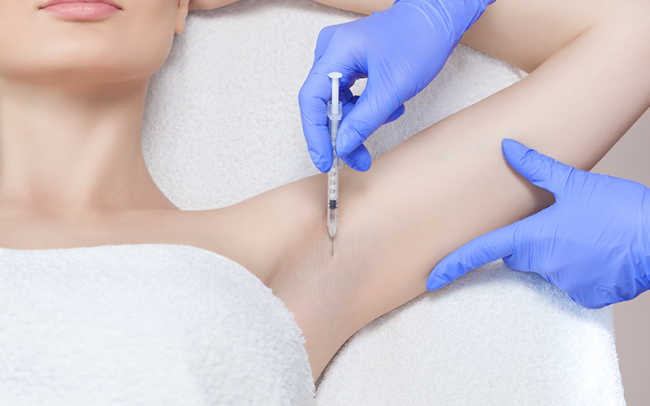For most people, Botox is considered a great way to treat fine lines and wrinkles. But for many others, it provides a solution to an uncomfortable and often embarrassing condition called hyperhidrosis.
Hyperhidrosis is excessive, abnormal sweating that isn’t related to heat or to physical exertion; it can even soak through your clothes or make your hands drip with sweat. It usually occurs on both sides of your body and can affect your hands, feet, face, underarms or under your breasts.
“There isn’t a known medical cause for this, but it does tend to run in families, and it oftentimes will get worse when people are nervous or under stress,” says Dr. Jennifer D. Holman, a board-certified dermatologist at the Center for Aesthetic and Laser Medicine (CALM) in Tyler, Texas.
“Hyperhidrosis can affect people in many negative ways, such as interfering with their social lives or even affecting their pursuit of career goals. People who suffer from hyperhidrosis will go to great lengths to try to get this resolved.”
Treatments for hyperhidrosis have changed over time; they have included invasive procedures, such as surgery to interrupt the nerve signal and sweat gland removal, or medications including prescription creams or antiperspirants, nerve-blocking medications, and antidepressants.
In 1994, OnabotulinumtoxinA, or Botox, was studied as a possible solution to hyperhidrosis. Researchers noted that, with the use of Botox, dermatologists had discovered a safer, more effective way to treat the condition.
Understanding How to Treat Hyperhidrosis
For anyone who suffers from heavy sweating, the first step is to get tested to make sure that it’s actually a case of hyperhidrosis and not a different health condition. There can be other medical reasons for excess sweating, such as diabetes, thyroid problems, heart attack, infections, low blood sugar and hot flashes related to menopause. Once a doctor confirms it’s hyperhidrosis, you can begin to look at treatment options.
“Treatments have improved and options have expanded over the past few years,” Dr. Holman says. “Finding the treatment that’s right for you is important because this can definitely affect your quality of life.”
Oral medications can have side effects or can interact with prescriptions you take for other conditions. Surgeries are invasive and have been linked to irreversible side effects. And, unfortunately, not all treatments are effective for treating all the areas where excess sweating occurs. In fact, only two forms of treatment — Botox and prescription antiperspirants — are indicated as being successful for treating the underarms, face, head, feet, and hands.
Why Botox Works So Well for Hyperhidrosis
Dr. Holman explains that Botox is often used when other treatments have failed. This natural, purified protein is able to temporarily block the body from secreting a chemical that turns the body’s sweat glands on and off. When the Botox is injected, it essentially turns off the sweating function at the site of the injection.
“One of the reasons people like using Botox for excessive sweating so much is that the results start within a couple of days of getting the injections,” she says. “Within two weeks, the full effect of the treatment should be realized.”
According to the International Hyperhidrosis Society, research has proven that Botox is a safe and effective way to treat the condition. It results in an 82 to 87 percent decrease in sweating, and the effects of the injections can last from four months to a year, although in some cases patients have found them to last as long as 14 months.
“There has been a lot of research done showing how this makes long-lasting improvements in the patient’s condition and provides them with a better quality of life and improves their daily functioning,” says Dr. Holman.
In order to receive the best results, make sure that you only allow an experienced, licensed practitioner to perform the procedure.
How It’s Done
Because it’s a simple injection, the procedure can be done in a doctor’s office in just a few minutes, and it won’t require any downtime or restrictions from activities afterward.
“It’s really as simple as getting any other Botox treatment,” explains Dr. Holman. “You’ll receive multiple injections, depending on the area that needs to be treated. The injections use a fine needle and are done just under the skin.”
Dr. Holman says that a follow-up visit is advised one to two weeks after receiving the injections to make sure you are getting the maximum benefit of the treatment and to make additional injections in any areas that might have been missed.
“Botox is a very simple and effective way to treat hyperhidrosis,” she adds. “While there are some people with pre-existing conditions that would not be good candidates for this procedure, it’s going to be a safe way for most people suffering from hyperhidrosis to find relief and go back to enjoying their lives.”
Looking to Visit a Dermatologist for Hyperhidrosis?
To find out more about whether or not you are a good candidate to treat your hyperhidrosis with Botox, schedule an appointment with a board-certified dermatologist near you. We have multiple locations throughout the country, so fill out our simple online form to get in touch with us. One of our local team members will reach out to you shortly to answer your questions or schedule an appointment for you to visit us soon.
Find a location near me
or

